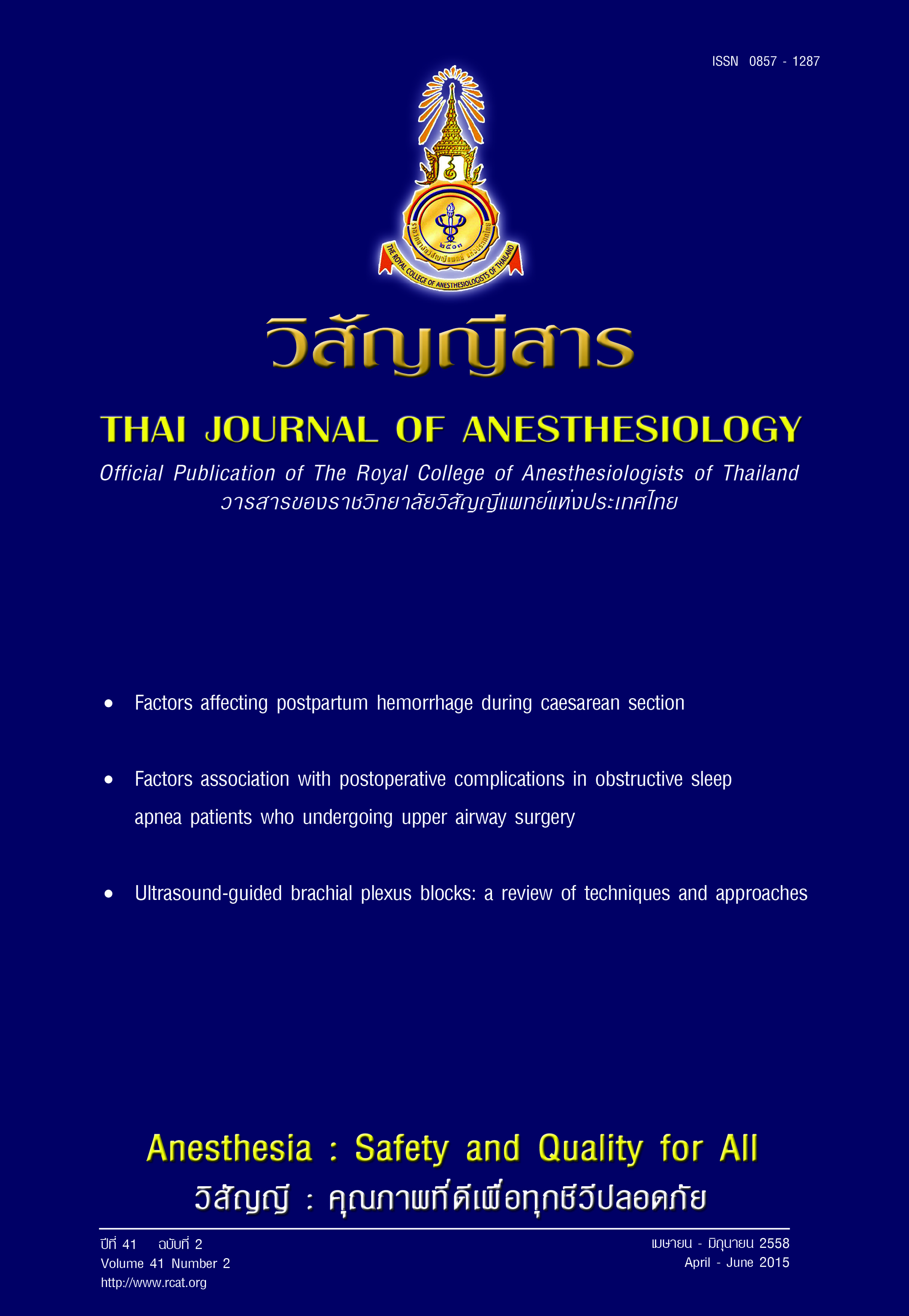Factors association with postoperative complications in obstructive sleep apnea patients who undergoing upper airway surgery
Main Article Content
Abstract
Background: The incidences of postoperative complications in obstructive sleep apnea (OSA) patients are higher than in normal healthy patients especially airway surgery.
Objective: To investigate postoperative complications and to find out the risk factors.
Method: A retrospective reviews of 188 OSA patients who underwent upper airway surgery were done. Apnea - hypopnea index (AHI), lowest oxygen saturation during sleep, difficult intubation, postoperative airway device used, lowest postoperative oxygen saturation, operation time (OPT), and postoperative complications were assessed to be potential factors. Adjusted odds ratios (aOR) and 95% confidence interval were presented for multivariate logistic regression analysis.
Results: The overall complications and respiratory complication were 27.7% and 21.3% respectively. The patients with postoperative complications had higher AHI (45.2 ± 33.2 / hour vs. 31.6 ± 26.8 / hour; p = 0.01) and longer OPT (196.8 ± 108.0 min vs. 145.3 ± 55.3 min; p = 0.002 ). Patients who had an AHI > 55 /hour were more likely to have complications and respiratory complications than the patients who had an AHI ≤ 55 /hour (aOR = 2.32, 95%CI = 1.08 – 4.99 and aOR = 2.33, 95% CI = 1.06 – 5.13 respectively) as well as OPT > 130 min compared to OPT ≤ 130 min (aOR = 4.02, 95% CI = 1.81 -8.96 and aOR = 4.67, 95%CI = 1.81 – 12.04 respectively).
Conclusion: Patients with AHI > 55 /hour, OPT > 130 min were more likely to have postoperative complications.
ปัจจัยที่มีผลต่อภาวะแทรกซ้อนหลังการผ่าตัดทางเดินหายใจส่วนบน ในผู้ป่วยที่มีภาวะหยุดหายใจขณะนอนหลับ
บทนำ: ผู้ป่วยที่มีภาวะหยุดหายใจขณะนอนหลับ (OSA) ที่ได้รับการรักษาโดยวิธีผ่าตัดทางเดินหายใจส่วนบนจะมีภาวะแทรกซ้อนหลังการผ่าตัดมากกว่าผู้ป่วยปกติ
วัตถุประสงค์: เพื่อศึกษาอุบัติการณ์ของภาวะแทรกซ้อน และ ปัจจัยเสี่ยงที่มีผลต่อภาวะแทรกซ้อนหลังการผ่าตัด
วิธีการศึกษา: เป็นการศึกษาย้อนหลัง ผู้ป่วย 188 คน ที่ได้รับการผ่าตัด ทางเดินหายใจส่วนบน เก็บข้อมูลค่า ค่าดัชนีการหยุดหายใจและหายใจแผ่ว[apnea - hypopnea index (AHI ), ค่าออกซิเจนต่ำสุดขณะหลับ, การใส่ท่อหายใจยาก, การใช้ airway device (POAW) หลังการผ่าตัด, บันทึกค่า oxygen saturation ต่ำสุดหลังผ่าตัด (LOPO), ระยะเวลาของการผ่าตัด (OPT), และภาวะแทรกซ้อนอื่นๆ (OC) นำมาวิเคราะห์ทางสถิติเพื่อหาปัจจัยเสี่ยง
ผลการศึกษา: ภาวะแทรกซ้อนและภาวะแทรกซ้อนทางการหายใจ เท่ากับ 27.7% และ 21.3% ตามลำดับผู้ป่วยที่มีภาวะแทรกซ้อนหลังผ่าตัดจะมีค่า AHI สูงกว่า (45.2 ± 33.2 / ชั่วโมง vs. 31.6 ± 26.8 / ชั่วโมง; p = 0.01 ) and OPT นานกว่า (196.8 ± 108.0 นาที vs. 145.3 ± 55.3นาที; p = 0.002) ผู้ป่วยที่มี AHI > 55 /ชั่วโมง จะพบภาวะแทรกซ้อน และภาวะแทรกซ้อนทางการหายใจ มากกว่าผู้ที่มี AHI ≤55 /ชั่วโมง (aOR = 2.32, 95%CI = 1.08 – 4.99 และ aOR= 2.33, 95% CI = 1.06 – 5.13 ตามลำดับ) เช่นเดียวกันผู้ที่มี OPT > 130 นาที จะพบภาวะแทรกซ้อน และภาวะแทรกซ้อนทางการหายใจ มากกว่าผู้ที่มี OPT ≤ 130 นาที ( aOR = 4.02, 95% CI = 1.81 -8.96 and aOR = 4.67, 95% CI = 1.81 – 12.04 ) ตามลำดับ
สรุปผล: ผู้ป่วย OSA ที่มี AHI > 55 และ OPT > 130 จะเสี่ยงต่อการมีภาวะแทรกซ้อนหลังการผ่าตัด


